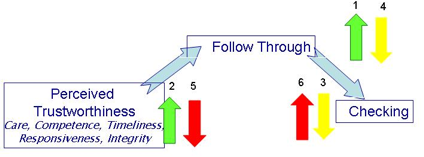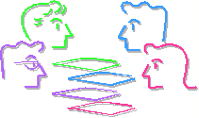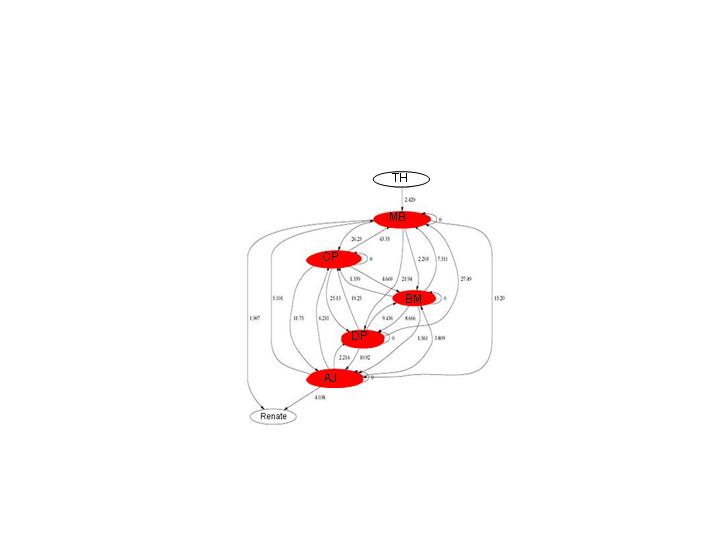Trust in Global Teamwork
Roxanne Zolin and Renate Fruchter
1999-2003
The availability, accessibility, and affordability to the Internet have extended the distance over which team members can collaborate on projects. The development of trust among team members is a critical concern for any team and becomes even more challenging in distributed, global teams. Research into remote and distributed teams is finding that computer mediated communication changes interactions. Can we predict failure of trust in distributed teams? When do people care about trust? When they have to work with someone that is not trusted, or when they want to contribute but are not trusted. Our working definition is that TRUST is a deciding factor in a social process that leads to a decision to accept a risk that another person will meet certain behavioral expectations. Our unit of analysis was the dyad. We studied the dyadic relation described as “A trusts B to do X.” Our analysis focused on the notion of perceived trustworthiness as a function of – care, competence, timeliness, responsiveness, and integrity. We found that follow-through mediates the relation between perceived trustworthiness and checking.
Zolin, R., Fruchter, R., and Levitt, R., (2000) “Building, Maintaining, and Repairing Trust in Global A/E/C Teams,” Proc. of ASCE ICCCBE-VIII Conference, ed. R. Fruchter, K. Roddis, F. Pena-Mora, Stanford, August 14-16, 2000, CA.
Zolin, R., Hinds, P., Fruchter, R., and Levitt, R. (2001). Trust in cross-functional global teams. Paper presented at the authors meeting for the Organization Science Special Issue "Trust in an Organizational Context", Milan, Italy.
Zolin, R., Hinds, P., Fruchter, R., and Levitt, R., (2004) "Interpersonal Trust in Cross-Functional, Geographically Distributed Work," Information and Organization Journal, Vol 14, Issue 1, 1-26.
Culture and Communication Channels
Alicia Townsend and Renate Fruchter
2000-2002
- What are key cross-cultural dimensions to be considered in distributed teams?
- How do cultural dimensions and differences relate to preferences of communication channels? How does the usage of these tools differ from culture to culture and why?
- What are the typical problems that arise when members of different cultures need to work together?
- What types of tools and communication channels should be available to collaborate online?
Fruchter, R. and Townsend, A. “Multi-cultural Dimensions and Multi-Modal Communication in Distributed Cross-Disciplinary Teamwork,” Proc. of 3rd Mudd Workshop, Ed. C. Dym, May 2001.
Fruchter, R. and Townsend, A. “Impact of Multi-Cultural Dimensions on Multi-Modal Communication in Global A/E/C Teamwork,” in Proc. of 2002 ASEE National Conference, Montreal, Canada, June 2002.
Fruchter, R. and Townsend, A. “Multi-cultural Dimensions and Multi-Modal Communication in Distributed Cross-Disciplinary Teamwork,” International Journal of Engineering Education IJEE 2003, Vol 19, Nr. 1, 53-61.
Emergent Work Practices
Renate Fruchter and Yun Chyi Chao
2003-2006
This study focused on emerging work processes and practices in the AEC Global Teamwork, i.e., what people experience in interacting with the technologies, why people practice in the way they do, how the practice fits into the environment and change the work patterns. The observations and implications represent the blueprint for yearly innovations and improvements to the design of the AEC Global Teamwork program established in 1993 the Civil and Environmental Engineering Department, at Stanford University. The analysis is structured under three questions:
- How people make choices – how AEC teams adopt and abandon the collaborative technologies,
- How people’s interaction is mediated by the tools – the roles of the technologies in the team’s interaction, and
- How the technology in practice affects the team’s work patterns – the emergent work practice.
We observed and defined stages in which the roles of technologies evolved and became idiosyncratic to AEC global teams. We identify the three stages: Stage 1: Preparation for collaboration – The adoption and abandonment, Stage 2: Adaptation – The transition from visible to invisible, and Stage 3: Idiosyncratic Usage – The coupling ready-to-hand and present–at–hand.
Explicit choices need to be made by the team members in order to achieve high-performance teamwork. These explicit choices are: core team values, mode of operation, and the corresponding IT tools. As the team goes through the three stages, the team members’ behavior will evolve, the team will adopt an emergent work practice, and ultimately, a new business process will be defined.
Fruchter, R., and Chao, Y.C., (2004) “AEC Global Teamwork: Emergent Work Processes,” Proc. of ICCCBE-X 10th International Conference on Computing in Civil and Building Engineering, Weimar, 2004. CD.
Fruchter, R. (2006) “Explicit Choices and Emergent Work Practices in Global Teamwork,” Proc ICCCBE-XI International Conference on Computing in Civil and Building Engineering, Montreal, June 2006. CD.
Influence Leaders in Global Teamwork
Renate Fruchter, Shubashri Swaminathan, Jyotika Prasad, Shohini Banerjee, Naohiro Matsumura, and Yukio Ohsawa
2004-to date
The process of designing and constructing modern buildings depends for its success on the effective communication of ideas among stakeholders with different backgrounds who are likely to be geographically distributed. Architecture, Engineering, and Construction (AEC) global project teamwork is communication intensive and relies heavily on synchronous and asynchronous information and collaboration technologies (ICT). The use of ICT shapes work processes and social interactions among team members, and team members reshape ICT and the way it is used. We explore in this study how an asynchronous ICT, called ThinkTank, shaped the work practice of design-construction global teams, and how the interaction with this ICT reshaped the purpose and benefits of its use. ThinkTank is a web-based asynchronous collaboration and discussion forum developed by the PBL Lab at Stanford University. We introduce the Influence Diffusion Model (IDM) that formalizes the process of identifying the influence of people, messages, and terms mathematically. Discovering who the influence leaders in project teams are can be beneficial and critical from a corporate management perspective, since they can guide or motivate the team towards successful actions and outcomes. We developed the ThinkTank-IDM integrated system. We demonstrate how the use of IDM applied in the context of AEC global teamwork discussion forums in ThinkTank can assist to identify influence leaders, influence topics, and social interaction dynamics over time. We use a ThinkTank testbed of fifty three project team forums archived over eight years to validate the ThinkTank-IDM system.



